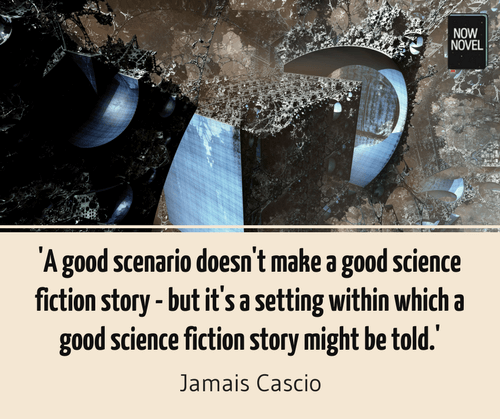Novel idea generators and writing prompts are some tools for finding ideas for a story. Yet once you have your central idea – the single sentence that encapsulates the key, interesting details – you need to expand this so you’re ready to draft. Here are tips for finding interesting plots, sub-plots, characters and settings in your novel idea. Use them to fill out your story with interesting scenes that stay relevant to your starting story scenario:
1. Find latent character goals in your novel idea
Your central idea helps guide your storytelling decisions. [The first step in Now Novel’s dashboard is dedicated to this task.]
Once you have this idea, start expanding. Read over your central idea and ask:
- How would this situation emotionally affect characters living it out?
- What might a main character in this situation want?
- What obstacles could there be to attaining their desire?
Let’s apply this idea to a central idea from a recent New York Times bestseller:
‘Sergeant Detective D.D. Warren teams up with a torture survivor to find a missing teenager whose family was gunned down.’
This is the one line synopsis Hawes supplies for Lisa Garnder’s 2018 mystery-thriller Look for Me.
Using the questions above, if this were your central idea you might ask, ‘How does the torture survivor’s past affect the lead characters’ work together?’
You could ask, ‘What does my detective want?’ Most likely it’s to solve the crime, foremost.
Meanwhile, the torture survivor might have additional motives of their own. The desire for retributive justice, driven by their own pain or anger, for example.
For the third question, you could ask, ‘How does the missing person being a teenager complicate the situation?’ Given their youth and their backstory, it’s possible they’re in hiding and don’t want to be found, for example.
Ask questions that unpack the world of possibility in your novel idea. Make notes on characters’ connections with others. Ensure you pick the most convincing character goals:
- Focus on cause and effect: How could X backstory possibly affect the choices a character makes in the presently unfolding story?
- How will this specific character goal contribute to the possible end-point of the story (e.g. in a murder mystery, solving the crime)

2. Brainstorm goal complications and obstacles that will add suspense
We often associate ‘suspense’ with mystery, horror, thriller and other genres involving higher degrees of conflict. In truth, suspense is key to every good story. Open a Dr Seuss book such as ‘The Cat in the Hat’ and you’ll notice there’s an underlying tension between what we know and don’t yet know. That’s what you might call ‘narrative suspense’.
Once you’ve found character goals embedded in your central idea, think about potential obstacles to these goals.
If we take Gardner’s novel idea above, for example, we might wonder:
- What might prove difficult about this collaboration? The different emotional baggage her detective and trauma survivor bring to their investigation?
- How were the mystery gunners connected to the other (teen) survivor’s family? Is there a connection that aids or hinders the investigation?
Great obstacles and complications that create suspenseful detours from characters’ main goals include:
- Internal conflicts: For example, addiction that threatens a character’s ability to think or choose well
- External conflicts: Your detective might have a non-cooperative colleague or local community, or maybe the environment itself (a wintry cold snap that turns the landscape into an inhospitable menace)
- Unexpected setbacks: What could happen in a tense investigation to set the process back? Evidence tampering is one possibility. In a fantasy novel, an event diminishing characters’ magical powers is another possibility
3. Imagine settings adding mood and possible subplots
Once you have a novel idea, mine it for setting ideas. [This is also a core part of the Now Novel process.]
Let’s take another example and explore how a novel idea can stimulate setting inspiration:
‘Three students at a sleazy for-profit law school hope to expose the student-loan banker who runs it.’
This is the premise for John Grisham’s The Rooster Bar (2017).
Grisham’s novel idea already gives us a good indication of setting, character goals, and a villain/antagonist. There’s a clear central arc for the story already.
What about the setting, a ‘sleazy for-profit law school’. How could you show the sleaziness of the setting?
- Place description: How might the school’s appearance physically suggest sleaziness and the banker’s greed being prioritized over educational values? For example, perhaps a lot of money has been lavished on luxury fittings and reception areas, but the actual school resources are woefully inadequate
- Wordbuilding: How could you describe such a school, generally, in terms of culture? Perhaps there’s a culture of sexism, racism, and other bigoted behaviour entrenched in the school because of its ‘money-first, students second’ structure
Once you have core settings, think of other interesting secondary settings. For example:
- What are the dorms like? How do the politics of the head honcho filter down into the student body?
- How does the world of the school spill over into neighbouring areas? Some students, in a subplot, might go into the neighbouring town and pick fights. Such an event yields an additional setting to explore
From the above, see how a single, interesting setting with a prevailing mood (e.g. sleaziness) can inspire further setting details that relate to your story’s central problem (in Grisham’s case, the prioritizing of profit over values such as fairness and social or corporate responsibility).

4. Find subplots that support your main novel idea
Subplots are a key part of how to expand a novel idea so it has more than one simple arc. Subplots have multiple purposes:
- Supporting primary story and character arcs: Great subplots show, for example, background personal details affecting characters’ primary arcs and desires
- Developing key themes and ideas: For example, in a story about the struggle between benevolent and malevolent forces, a subplot could show the way ordinary people are corrupted in the first place (like Gollum’s corruption by the Ring in Tolkien’s The Hobbit)
Let’s look at another novel idea and think about the subplots we could mine from it:
‘A former prisoner of war returns from Vietnam and moves his family to Alaska, where they face tough conditions.’
This idea (the premise for Kristin Hannah’s The Great Alone (2018)) immediately presents possible subplots:
- How the relocation affects individual family members: Each family member could have their own arc illustrating how different people cope with momentous life change. A teenage family member, for example, might go off the rails and get into self-destructive behaviour as they struggle with the change.
- Remnants from the war: The main character could be visited by a former co-prisoner, for example, this ‘blast from the past’ prompting flashbacks illustrating the hardships of life as a prisoner of war.
The above subplots could thus add complications, as well as an emotional intensity to the primary character’s ‘New Life’ story arc. Showing how characters’ choices and paths intersect and affect each other and exploring the dramatic potential therein is key to strong subplots.
5. Identify interesting potential themes
Themes are the recurring motifs and ideas in stories. For example, popular sayings such as ‘be careful what you wish for’. Or else ideas such as ‘there’s power in numbers’ .
A single novel idea often contains the seeds of multiple timeless themes. For example, Grisham’s ‘David vs Goliath’ theme. How will comparatively powerless students at the sleazy law school take on the director?
In ‘David vs Goliath’ stories, the character who appears smaller/weaker often has a hidden strength. For example, students are able to mobilize fellow students and could create a wave of unstoppable change more powerful than the head’s money.
Let’s look at a concrete example of a novel idea and the theme inspiration it supplies:
‘A recluse who drinks heavily and takes prescription drugs may have witnessed a crime across from her Harlem townhouse.’
This is the premise of The Woman in the Window by A.J. Finn. It’s been called ‘the hottest new release thriller of 2018’.
Finn’s book idea suggests interesting possible themes. For example, ‘the relationship between truth and power’. As a recluse (a social outsider) who also suffers from addiction, how much power does the witness to the possible crime have?
Will people believe her if she reports the crime or not? What consequences could she face for getting involved? Individual scenes could explore themes of the relationship between truth and power (e.g. the idea that powerful people have more say in defining the truth).
Need help developing your novel idea into a complete manuscript? Enroll in Kickstart your Novel and work with a writing coach to develop your first three chapters and a guiding synopsis. Or take the DIY route and use the tools in the members area to flesh out and expand your main idea.


4 replies on “How to expand your novel idea into a stronger story”
Cool article, I love your explanation of creating suspense. You don’t need to be writing a Jason Bourne novel to create susspense
Absolutely, all great stories have a little suspense, no matter how mild, you could say. Thank you for reading.
Thanks for the great tips.
Thanks for reading our blog, Scott!